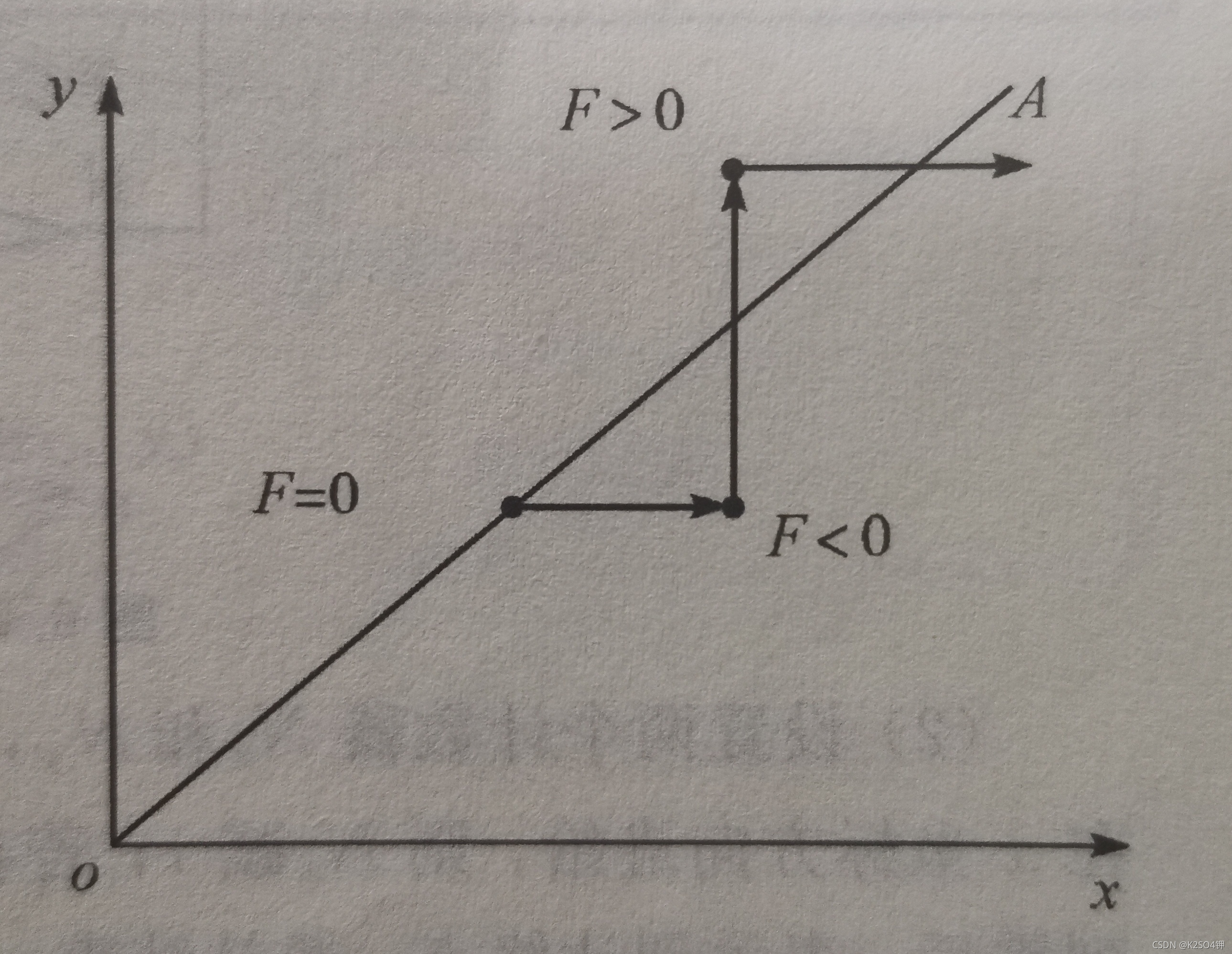阅读前请注意:
1. MATLAB深入学习是在MATLAB学习笔记的基础上的深度学习,学习这一部分内容需要有较夯实的MATLAB基础,不建议在未掌握基础知识的情况下学习本内容。博客内容由 @K2SO4钾 撰写、编辑,发布于 @K2SO4钾 的个人投稿与华中师范大学HelloWorld程序设计协会CSDN官方账号 @CCNU_HelloWorld 。注意,如需转载需得到作者 @K2SO4钾 的同意与授权!
2. 内容中的代码、示例均为作者原创,内容中的引用、参考等非原创内容均会以参考文献的方式在文末标出。
3. 笔记中示例用MATLAB版本为MATLAB R2019a。
4. 请谅解笔记可能会出现的错误,欢迎指正讨论;由于MATLAB更新导致的旧代码无法使用的情况,也欢迎讨论交流。
文章目录
S6.0 MATLAB学习笔记:传送门汇总
S6.0.1 MATLAB学习笔记:传送门汇总
S6.0.2 MATLAB拓展学习:传送门汇总
MATLAB拓展学习T2:程序性能优化技术
MATLAB拓展学习T3:histogram函数详解
MATLAB拓展学习T4:数据导入与查表技术
S6.0.3 MATLAB深入学习:传送门汇总
MATLAB深入学习S1:简单数字滤波技术的MATLAB实现(1)
MATLAB深入学习S2:无限脉冲响应数字滤波器
MATLAB深入学习S3:简单数字滤波技术的MATLAB实现
MATLAB深入学习S4:元胞自动机原理及MATLAB实现
MATLAB深入学习S5:图像处理技术
MATLAB深入学习S6:数字控制技术——逐点比较法插补原理
S6.0.4 MATLAB应用实例:传送门汇总
MATLAB应用实例Y1:Floyd算法
S6.1 逐点比较法——直线插补
由于我们的机械臂、刀具或者绘画笔很多时候是由电机操控的,而电机操控的方向有限(一般来说在二维平面内就是横轴方向和纵轴方向,三维平面内还需要考虑z轴方向。文章仅分析二维平面内的横纵方向),因此对于一些“斜着走”或者是“按弧线运动”的轨迹,电机操控的机械臂、刀具或者绘画笔不能精确地按照轨迹的方式运动。
逐点比较法插补其实很好理解,就是把刀具此刻的位置与给定的轨迹(或是理想的轨迹)作比较,看一看目前点是在轨迹的上方还是下方,在轨迹的内侧还是外侧,从而决定下一步到底是横向移动还是纵向移动。不论是横向移动还是纵向移动,都会存在一个“步长”,即移动的最小值,所有的移动距离都是其倍数。当 这个步长很小时,采用逐点比较法进行插补,就可以较精确地对任意方向的直线轨迹进行刀具的移动。
对于曲线,由微积分思想,我们可以 把一条曲线分为若干条直线相连。对每条直线进行上述的方法,再将每条直线刀具预期运行的方式结合到一起,最终就是刀具在整条曲线上的预期移动轨迹了。当然,如果曲线划分为直线“分得太细”,则会导致代码运行时间过长,存储占用过多,代价较大。因此 对于曲线来说,如果精确度要求较高,那么逐点比较法的直线插补是不适用的。

大致的原理讲完了,现在来讲一讲细节:
(1)不同象限的直线插补方法稍有差别
与其说是“不同象限的直线”,更准确的说法是从起始点到终点的方向。在确定起点向终点的方向后:
如果方向是第一象限或横轴正方向:
如果目前刀具所在点在轨迹上或者上方,刀具应向右步进;
如果目前刀具所在点在轨迹下方,刀具应向上步进;如果方向是第二象限或横轴负方向:
如果目前刀具所在点在轨迹上或者上方,刀具应向左步进;
如果目前刀具所在点在轨迹下方,刀具应向上步进;如果方向是第三象限:
如果目前刀具所在点在轨迹上或者在其下方,刀具应向左步进;
如果目前刀具所在点在轨迹上方,刀具应向下步进;如果方向是第四象限:
如果目前刀具所在点在轨迹上或者在其下方,刀具应向右步进;
如果目前刀具所在点在轨迹上方,刀具应向下步进;如果方向是纵轴正方向或负方向
刀具向上或下步进
(2)何时为运行结束
当刀具落在终点坐标范围 ( 步 进 长 度 ) / 2 (步进长度)/2 (步进长度)/2 之上或之内,就可以认为刀具移动结束。
(3)以曲线为理想轨迹时
以曲线为理想轨迹时,需要注意将其分割的直线不能过多,否则运行开销太大。其次,将所有直线记录下的刀具移动轨迹进行合成时,要删除两个轨迹中首尾重复的点。
以下为整合的函数和测试的程序。(该函数稍有问题,会在后续的更新中修复。但是原理是正确的)
function [res_x,res_y] = PBPC_Linear_Interpolation(start_x,start_y,current_x,current_y,end_x,end_y,step_x,step_y)
%
% Take step_x and step_y as the step values in the horizontal and vertical directions,
% then use the point by point comparison method to return the linear interpolation
% from point (start_x, start_y) to point (end_x, end_y)
%
% 以step_x,step_y为横纵方向步进值,逐点比较法返回从点(start_x,start_y)到点(end_x,end_y)的直线插值
%
% 输入参数(start_x, start_y):开始点横纵坐标
% 输入参数(end_x, end_y):结束点横纵坐标
% 输入参数(current_x,current_y):刀具或绘笔图目前所在的位置
% 输出参数step_x,step_y:刀具或绘笔图的步进值
% 输出参数(res_x,res_y):刀具或绘笔图的轨迹
%
% 常用调用方式:
% [res_x,res_y] = PBPC_Linear_Interpolation(start_x,start_y,current_x,current_y,end_x,end_y,step_x,step_y)
%
% 编写于2021年10月19日17:26 程序员:K2SO4钾
%
if start_x == end_x
res_x = [];
res_y = [];
res_x(1) = start_x;
res_y(1) = start_y;
counter = 2;
if end_y >= start_y
while(1)
if current_x >= end_x-step_x/2 && current_x <= end_x+step_x/2 && ...
current_y >= end_y-step_y/2 && current_y <= end_y+step_y/2
break
end
current_y = current_y+step_y;
res_x(1,counter) = current_x;
res_y(1,counter) = current_y;
counter = counter+1;
end
else
while(1)
if current_x >= end_x-step_x/2 && current_x <= end_x+step_x/2 && ...
current_y >= end_y-step_y/2 && current_y <= end_y+step_y/2
break
end
current_y = current_y-step_y;
res_x(1,counter) = current_x;
res_y(1,counter) = current_y;
counter = counter+1;
end
end
end
if start_y == end_y
res_x = [];
res_y = [];
res_x(1) = start_x;
res_y(1) = start_y;
counter = 2;
if end_x >= start_x
while(1)
if current_x >= end_x-step_x/2 && current_x <= end_x+step_x/2 && ...
current_y >= end_y-step_y/2 && current_y <= end_y+step_y/2
break
end
current_x = current_x+step_x;
res_x(1,counter) = current_x;
res_y(1,counter) = current_y;
counter = counter+1;
end
else
while(1)
if current_x >= end_x-step_x/2 && current_x <= end_x+step_x/2 && ...
current_y >= end_y-step_y/2 && current_y <= end_y+step_y/2
break
end
current_x = current_x-step_x;
res_x(1,counter) = current_x;
res_y(1,counter) = current_y;
counter = counter+1;
end
end
end
if start_x ~= end_x
k = (start_y-end_y)/(start_x-end_x);
x0 = start_x;
y0 = start_y;
syms x
func = matlabFunction(k*(x-x0)+y0);
res_x = [];
res_y = [];
res_x(1) = start_x;
res_y(1) = start_y;
counter = 2;
if end_x > start_x && end_y >= start_y
while(1)
if current_x >= end_x-step_x/2 && current_x <= end_x+step_x/2 && ...
current_y >= end_y-step_y/2 && current_y <= end_y+step_y/2
break
end
if current_y >= func(current_x)
current_x = current_x+step_x;
res_x(1,counter) = current_x;
res_y(1,counter) = current_y;
counter = counter+1;
else
current_y = current_y+step_y;
res_x(1,counter) = current_x;
res_y(1,counter) = current_y;
counter = counter+1;
end
end
elseif end_x < start_x && end_y >= start_y
while(1)
if current_x >= end_x-step_x/2 && current_x <= end_x+step_x/2 && ...
current_y >= end_y-step_y/2 && current_y <= end_y+step_y/2
break
end
if current_y >= func(current_x)
current_x = current_x-step_x;
res_x(1,counter) = current_x;
res_y(1,counter) = current_y;
counter = counter+1;
else
current_y = current_y+step_y;
res_x(1,counter) = current_x;
res_y(1,counter) = current_y;
counter = counter+1;
end
end
elseif end_x > start_x && end_y < start_y
while(1)
if current_x >= end_x-step_x/2 && current_x <= end_x+step_x/2 && ...
current_y >= end_y-step_y/2 && current_y <= end_y+step_y/2
break
end
if current_y <= func(current_x)
current_x = current_x+step_x;
res_x(1,counter) = current_x;
res_y(1,counter) = current_y;
counter = counter+1;
else
current_y = current_y-step_y;
res_x(1,counter) = current_x;
res_y(1,counter) = current_y;
counter = counter+1;
end
end
elseif end_x < start_x && end_y < start_y
while(1)
if current_x >= end_x-step_x/2 && current_x <= end_x+step_x/2 && ...
current_y >= end_y-step_y/2 && current_y <= end_y+step_y/2
break
end
if current_y <= func(current_x)
current_x = current_x-step_x;
res_x(1,counter) = current_x;
res_y(1,counter) = current_y;
counter = counter+1;
else
current_y = current_y-step_y;
res_x(1,counter) = current_x;
res_y(1,counter) = current_y;
counter = counter+1;
end
end
end
end
end
%% 仿真
clc,clear all,close all
start_x = 0;
start_y = 3;
end_x = 16;
end_y = 18;
[X,Y] = PBPC_Linear_Interpolation(start_x,start_y,start_x,start_y,end_x,end_y,0.6,0.8);
subplot(121)
plot(X,Y,'linewidth',1.4)
hold on
line([start_x,end_x],[start_y,end_y],'color','r','linewidth',1.4)
title('图像1')
start_x = 0;
start_y = 3;
end_x = 120;
end_y = 140;
[X,Y] = PBPC_Linear_Interpolation(start_x,start_y,start_x,start_y,end_x,end_y,0.1,0.1);
subplot(122)
plot(X,Y,'linewidth',1.4)
hold on
line([start_x,end_x],[start_y,end_y],'color','r','linewidth',1.4)
title('图像2')

当步进很小时,刀具的移动轨迹和理想轨迹几乎重合(如右图)。
撰写:K2SO4钾(华中师范大学)